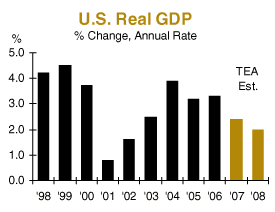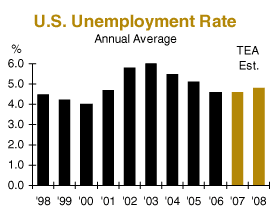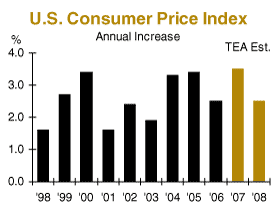|
December 5, 2007 (you may need to refresh your browser to view the latest issue)
Outlook 2008
Written by Jeff Thredgold, CSP, President, Thredgold Economic Associates
 The U.S. Economy The U.S. Economy
…how slow is slow?
Recession in 2008? Depends who you talk to. As before, we suggest about a 30%-40% chance of recession sometime during the next 12 months. More likely is a sluggish growth scenario, with a 0.5%-2.0% real (inflation adjusted) annual growth pace during the next six months. We expect better performance in 2008’s second half.
Housing weakness and credit market anxiety, combined with a constantly negative view from the national media, will make it “feel” like a recession. In contrast, surging American exports to a strong global economy led U.S. real growth to slightly exceed a 3.0% annual rate in 2007’s first three quarters.
The Federal Budget
…strong growth in revenues
A budget deficit of $162 billion (the smallest in five years) was recorded in fiscal year (FY) 2007, which ended on September 30.  Record gains in individual tax revenue, tied to income and investment tax cuts of recent years, led the deficit lower. The deficit will likely rise modestly in FY2008, with major long-term challenges as Baby Boomers retire. Record gains in individual tax revenue, tied to income and investment tax cuts of recent years, led the deficit lower. The deficit will likely rise modestly in FY2008, with major long-term challenges as Baby Boomers retire.
Employment
…a major long-term issue
U.S. economic weakness could see the nation’s unemployment rate approach 5.0% in coming months. In contrast, the unemployment rate averaged 4.6% during 2006 and 2007, below the averages of the ’70s, the ’80s, and the ’90s. The longer-term issue of tighter labor availability—especially for skilled workers—will challenge American businesses, both large and small.
Inflation
…high oil isn’t helping
Consumer prices will rise roughly 3.5% in 2007, aggravated by higher energy and food prices. Inflation pressures near 2.5% are likely in 2008. By comparison, the Consumer Price Index rose 2.5% in 2006, 3.4% in 2005, and 3.3% in 2004. Powerful competition in nearly all industries helps keep inflation under control.
 The Federal Reserve The Federal Reserve
…more ease to come?
The Federal Reserve cut its important federal funds rate by a total of 0.75% on September 18 and October 31, with the rate falling to 4.50%. We expect another cut on December 11, most likely 0.25%, with a solid chance of a 0.50% cut. Financial market anxiety will determine how the Fed responds.
If the economy stabilizes, the Fed will move to the sidelines. If the recession forecasters are correct, a federal funds rate approaching 3.00% could be on tap by next summer.
Long-Term Interest Rates
…wider spreads aren’t helping
Nervous investors always seek the highest quality and greatest liquidity, a process known as “flight to quality.” Global credit market anxiety has pushed U.S. Treasury Security yields to their lowest level in two years.
A 10-year U.S. Treasury Note yield near 4.00% would typically lead conforming 30-year fixed-rate mortgages to the “high 5s” rather than around 6.25%. However, spreads have risen as lenders remain very cautious. Wider “jumbo” mortgage spreads are clearly hurting the higher-end housing market. Let’s hope mortgage markets return to the norm in coming months.
Home Prices
…too far, too fast
Excessive home price gains on both coasts and in the Southwest during 2002 to 2006 gave way to a buyers’ market during 2007. The simple reason? The average American home value rose 46.92% between September 30, 2002 and September 30, 2007. Florida?…up 85.92%. Arizona?…up 85.27%. Nevada?…up 84.28%. California?…up 80.38%. These outsized gains result even after average price declines in these states during the past 12 months (source: OFHEO). These four states account for more than half of the national rise in foreclosures of the past year. National housing news may not get better until later in ’08.
The Global Economy
…a strong global marketplace
Strong global economic growth continues, although most forecasts have been revised lower in recent months, tied to heightened credit market anxiety. Still, global growth exceeding a 4.0% real annual rate in 2008 would be the sixth year in a row of strong performance. Other risks to solid global growth include any major terrorist atrocities (especially on American soil), even higher oil prices, and a worsening of Middle East tensions.
Japan has returned to modest economic growth in recent years following “the lost decade” of economic nothingness. The Japanese anxiously look over their collective shoulders as China gains in Asian and global influence. Strong Indian economic growth remains on track, led by solid domestic demand for goods and services. The disparity between the “haves” and “have nots” seems to be widening.
Powerful Chinese economic growth has led to further steps by political leaders to slow the economy. The highly emotional issue regarding the quality and safety of goods “Made in China” will be center stage in the U.S. for years to come, with many American consumers simply refusing to buy. China suffers from serious environmental damage, with polluted air in major cities and poisoned rivers the norm. The 2008 focus will be all about the Summer Olympics in Beijing during August. Given the dirty air, will we be able to see them?
Euro currency strength of recent years is great for Europeans doing their Holiday shopping on America’s East coast. However, it is scaring European exporters to death. Necessary labor reforms bode well for greater European competitiveness in coming years, particularly in Germany. The French are even becoming more competitive, with new political leadership taking on powerful unions.
Russian President Putin enjoys widespread support as enormous oil revenues have boosted the standard of living of millions of citizens. Putin continues to strengthen his control and punish his enemies. Even as he is required to step down as President in 2008, he will continue to run the show.
Various South American countries struggle with high taxes and stifling regulatory burdens. Brazilian economic growth is solid, while Venezuela remains a political powder keg. Oil field negligence, combined with last Sunday’s voter rejection of Chavez-proposed reforms, suggests this “leader” will shrink in influence in coming years.
Canadian job creation remains solid, with the latest 5.8% jobless rate at a 33-year low. A surging Canadian dollar will hurt U.S. visitation and Canadian exports to the U.S. The Mexican economy is growing at a reasonable pace, with the immigration issue highly charged on both sides of the Rio Grande.
The Bottom Line in 2008?
U.S. economic performance will slow in coming months, with mild recession a possibility. In addition, we expect: a slightly larger budget deficit…tight long-term labor availability…lesser inflation pressures…declining short-term interest rates…soft coastal housing markets, with U.S. housing weakness the norm during much of the year…and an anxious but impressive global economy.
Email this article to a friend
|
|
Subscribe to the Tea Leaf
Like what you just read? Have Jeff Thredgold’s Tea Leaf emailed to you free each week. Subscribe today.
|
|
|

“Tea”sers
Signs…
On Maternity Room Door: Push, Push, Push
Podiatrist’s Window: Time wounds all heels
Muffler Shop: No appointment necessary. We’ll hear you coming.
Send us a “Tea”ser of your own.

“Tea”stimonial
“Based on our members’ feedback, your presentations were one of the most highly regarded and commented on sessions. Below are a few direct attendee quotes I’d like to share with you:
‘Excellent: very captivating!’
‘Very insightful. Jeff is polished and extremely knowledgeable.’
‘Great presenter—he made economics fun!’
‘Entertaining while very informative.’
It was indeed a pleasure working with a professional of your caliber.”
—Thomas G. Moore, Executive Vice President, ALM, Members United Corporate Federal Credit Union
More testimonials
Invite Jeff Thredgold to speak at your next conference, meeting, or client function
If you like the Tea Leaf, you’ll love Jeff Thredgold’s live presentations. Jeff takes your audience on a timely, engaging, and entertaining tour of the U.S. economy and financial markets. Debunking some of today’s most common economic myths, he offers a clear picture of how the American economy is really performing and what that means for the future of your finances.
|

